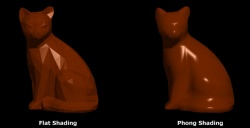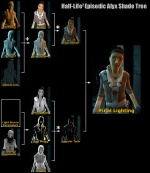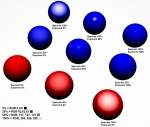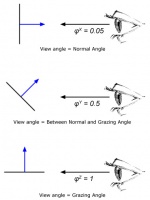Phong materials
With the release of ![]() Half-Life 2: Episode One a number of enhancements were made to the way lighting works within the
Half-Life 2: Episode One a number of enhancements were made to the way lighting works within the ![]() Source engine. The emphasis was on global illumination in order to ground characters in the game worlds and make them seem to be truly present in their environment.
Source engine. The emphasis was on global illumination in order to ground characters in the game worlds and make them seem to be truly present in their environment.
One of these enhancements was the addition of Phong shading for players with graphic cards using ps_2_b or later pixel shaders - around 70% of all users who played Half-Life 2: Episode One, according to the player stats. This new feature gives texture artists the ability to include Phong terms which can be driven by specular masks and exponent textures. These integrate naturally with the existing lighting and provide greater definition, particularly to key characters such as Alyx Vance.
The Phong shading can also include a Fresnel term in order to heavily favor rim lighting cases as opposed to general specular highlights. Under very bright lights, the specular rim highlights are often bright enough to bloom out in a dramatic fashion as a result of the Source engine's normal HDR post-processing.
A brief introduction to Phong shading
The following short introduction is not necessary knowledge to use the Source Phong shader, but does provide some technical insights as to how the technique works and may be of interest to some readers.
In simple terms, Phong shading is a technique used in 3D graphics to get better resolution of specular reflections. It was developed by Dr. Bui Tuong Phong at the University of Utah in 1973. His original publications combined the interpolation part of technique with his reflection model, the term Phong shading is commonly used to refer to either just the reflection model or to the combination of the reflection model and the interpolation method.
The Phong reflection model
The Phong reflection model is basically a simplified method of deciding the shade of a specific point on a 3D surface.
- It doesn't take into account second-order reflections often found in raytraced or diffuse rendering. To compensate an extra ambient lighting term is added to the scene that is rendered.
- It divides the reflection from a surface into three subcomponents - specular reflection, diffuse reflection and ambient reflection.
Phong reflection is an empirical model based on informal observation. Dr. Phong observed that for very shiny surfaces the specular highlight was small and that the intensity fell off rapidly, while for duller surfaces it was larger and fell off more gradually.

Phong interpolation
Phong shading provides a better approximation to a per-pixel application of an underlying reflection model by assuming a smoothly varying surface normal vector. The Phong interpolation method works particularly well when applied to the Phong reflection model or to any reflection model that has small specular highlights.
In some modern hardware, variants of the interpolation algorithm are called "pixel shading" (this should not be confused with "pixel shaders"). Usually this means that the lighting calculations can be done per-pixel and include other lighting variables such as surface normals from a normal map which are interpolated across the polygon.
Phong in the Source engine
While the above gives a fairly basic explanation of Phong shading as a concept, the effect you see in Episode One is in fact the result of a number of combined lighting effects working together. An overview of these effects and how they are combined can be seen in the diagram of the episodic shader tree.
With model lighting, Source uses methods which combine spatially varying directional irradiance samples from the radiosity solution with local light sources and environment mapping. On graphics hardware that supports 2.0 pixel shaders and lower, Source computes diffuse illumination from up to two local light sources, either per pixel or per vertex. On newer graphics chips with longer pixel shaders, Source includes specular contributions with Fresnel terms as well as more custom effects.
Phong shading is part of these extended effects and can be seen in the path starting bottom left of the shader tree. Phong exponent, mask and Fresnel terms are combined to give a specular term which is combined with the diffuse solution in the final output.
The rest of this document will focus on the Phong part of the shading tree explaining how the components work and how to create them.
Using the Phong shader
To use Phong shading with your models, you need to add the directive $phong 1 into your material's VMT file. This tells the shader to include a Phong pass when executing the shader code. You then need to define a Phong mask in your normal maps alpha channel, a Phong exponent either as a texture or constant and finally, parameters for remapping the Fresnel output.
Phong shader parameters
The following is a list of VMT parameters that are needed to enable the Phong effect.
$phong <bool>- Disable/enabled a Phong pass for this material.
$phongexponenttexture path/to/vtf- Filename of texture which defines Phong exponent per texel.
$phongexponent 0..255- Phong exponent for local specular lights. Overides
$phongexponenttextureapplying a defined constant exponent value over the whole texture. Default 5.0. $phongboost <float>- Phong overbrightening factor. The phong mask channel should be authored to account for this. Default 1.0.
$phongfresnelranges "[n n n]"- Parameters for remapping Fresnel output, Default [0 0.5 1].
$basemapalphaphongmask <bool>- Use the alpha channel of the
$basetextureas Phong mask. $basemapluminancephongmask <bool>- Use the luminance of the
$basetextureas Phong mask.
Example VMT for Phong
The following simplified example is taken from Half-Life 2: Episode One and comes from the file materials/models/Alyx/alyx_faceandhair.vmt which controls the texture on Alyx's face:
VertexLitGeneric
{
$basetexture models/Alyx/alyx_faceandhair
$bumpmap models/alyx/alyx_head_normal
$halflambert 1
$nodecal 1
$model 1
$phong 1
// $phongexponent 33
$phongexponenttexture models/Alyx/alyx_head_exponent
$phongboost 6
$phongfresnelranges "[0.05 0.5 1]"
}
Phong components and parameters in detail
Phong mask and exponent texture
The Phong mask is a greyscale image stored in the alpha channel of the models normal map (defined by $bumpmap). This mask defines on a per texel basis the intensity, or strength, of the Phong highlight for that texel. Black represents the lowest intensity and shows no Phong highlight at all (literally knocking it out), whereas white represents the brightest, or full intensity for that texel.
Instead of the normal map, the Phong mask can also be loaded from the alpha channel of the base texture, using the $basemapalphaphongmask 1 parameter. Alternatively, the luminance of the base texture can directly be used as the mask with $basemapluminancephongmask 1.
The Phong exponent defines the "tightness" of the highlight. A higher exponent results in a smaller, tighter highlight while a lower exponent results in a broader flatter one.
Different materials will exhibit highlights (tighter or broader) based upon their physical properties. A harder, smoother material such as a pool ball may have a very tight highlight while a softer, rougher material like a rubber tire may have a very broad specular highlight. In the Phong lighting equation, there is an exponent which mathematically controls the shape of the resulting highlight (tight or broad), hence the naming.
The Phong exponent texture can be defined in one of two ways:
$phongexponenttexturedefines a texture which on a per texel bases defines the exponent value for a surface.$phongexponentoverrides the exponent texture and is useful during development to get a quick overall specular term without painting a channel. It is then usually just commented out when a given texture map gets made and added to the mix for a given material.
The Phong exponent texture uses the red and green channels of the image for different purposes. The red channel defines the Phong exponent value and the green for albedo tinting. However, albedo tinting is a "work in progress" feature and currently un-supported in the current shader in some branches. For this reason, and the sake of simplicity, you should use greyscale for exponent textures.
Note: 05/2017 - *Albedo tinting through the green channel of the exponent texture does work in Source Filmmaker.
Phong boost
The Phong boost value is an overbrightening factor applied to the Phong mask channel. The Phong mask channel should be authored to take the Phong boost value into account for this. Values are unbound and can even be negative although this would probably provide worthless results.
Phong Fresnel ranges
The Fresnel ranges values control the optional Fresnel term which is used to give rim lighting to a model. In short, this brightens those surfaces of the model that face away from the players viewpoint. The nearer their surface is to being parallel to the viewing angle, the brighter they become. These brighter surfaces are picked up by the HDR pass giving them a bloomed effect.
To explain this in more detail, reflective surfaces increase in reflectivity as the angle of view approaches a grazing angle. Even a partially reflective surface theoretically becomes 100% reflective when the angle of view is parallel to the surface. This is called the Fresnel term. We can express how reflective a surface is using the symbol φ and with a value between 0 and 1.
In the VMT the Frensel Terms are defined using the format $phongfresnelranges [φX φY φZ]. X represents how reflective the surface is when the view angle equals the surface normal. Z represents reflectivity when the view angle equals the grazing angle. Y represents reflectivity half-way between these two.
The default range values for Alyx's face are [0.05 0.5 1] which gives a linear brightening of the surfaces as they turn away from the player's view point. You can see how this looks in the visualisation of the Fresnel term included with this article.
Although we've used values between 0 and 1 so far, the actual values are unbound and you can use any number you like. For example, in Day of Defeat: Source values of [1 3 8] can be seen. This is useful when you are using no Phong boost and your Phong mask and exponent textures are very dark to give a minimal Phong highlight. The large Fresnel range values effectively boost the Fresnel term without effecting the Phong highlights of the model.
[0 0 0] to disable it.These codes will show you How Fresnel work
//source engine fresnel Ranges
float Fresnel2( vec3 vNormal, vec3 vEyeDir )
{
float fresnel = 1-saturate( dot( vNormal, vEyeDir ) ); // 1-(N.V) for Fresnel term
return fresnel * fresnel; // Square for a more subtle look
}
float Fresnel(vec3 vNormal, vec3 vEyeDir, vec3 vRanges)
{
float result, f = Fresnel2( vNormal, vEyeDir ); // Traditional Fresnel
if ( f > 0.5f )
result = mix( vRanges.y, vRanges.z, (2*f)-1 ); // Blend between mid and high values
else
result = mix( vRanges.x, vRanges.y, 2*f ); // Blend between low and mid values
return result;
}
Notes
Thanks to Jason Mitchell of Valve with help preparing this article and for providing the pictures from his SIGGRAPH 2006 presentation.
Previously, the phong exponent textures were messed up in games using the Orange Box engine as they showed glossy white (noticable in DOD:S and in TF2 when using HWM models). Valve fixed this problem as of May 25, 2011.
See also
- $phong
- $envmap (specular reflections)
- $rimlight
- $lightwarptexture
External links
Mitchell, Jason, Gary McTaggart and Chris Green (Valve), Shading in Valve's Source Engine. Course 26: Advanced Real-Time Rendering in 3D Graphics and Games. SIGGRAPH, Boston, MA. August 2006:
There is a Substance Painter Shader for Source Engine Phong shader (with most functions),you can edit your textures easily now.
Remember to check for any notes left by the tagger at this article's talk page.







